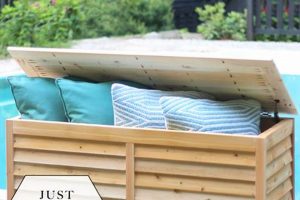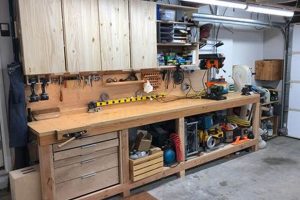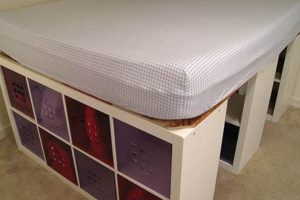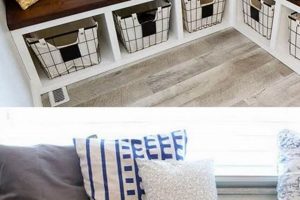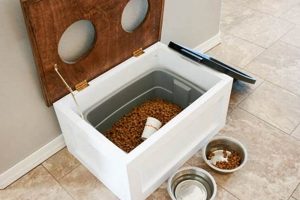Construction of a sleeping platform designed to accommodate a king-size mattress, incorporating integrated compartments for organization, can be undertaken as a do-it-yourself project. This approach allows for customization of dimensions, materials, and storage configurations based on individual needs and preferences. For instance, drawers can be built into the sides or foot of the structure to house bedding, clothing, or other personal items.
Such projects maximize space utilization, particularly beneficial in smaller living areas, offering a dual-purpose furniture item. Historically, resourceful individuals have often crafted their own furnishings to meet specific requirements and budgets. The practice fosters creativity and provides cost savings compared to purchasing pre-made furniture, while also allowing for sustainable choices through the use of reclaimed or recycled materials.
The following sections will address key considerations for planning and executing this type of project, including material selection, design strategies, construction techniques, and safety precautions. Furthermore, various storage solutions that can be integrated into the bed frame will be explored in detail, providing comprehensive guidance for individuals seeking to create their own functional and aesthetically pleasing bedroom furniture.
Construction Guidance
The following guidelines offer essential advice for building a king-sized sleeping platform with integrated organizational features. Adherence to these recommendations promotes structural integrity, safety, and optimal space utilization.
Tip 1: Material Selection is Paramount. Prioritize high-quality lumber, such as hardwoods (oak, maple) or durable plywood, to ensure longevity and stability. Consider the aesthetic qualities of the wood and its compatibility with existing bedroom dcor.
Tip 2: Accurate Measurements are Crucial. Obtain precise dimensions of the king-size mattress to guarantee a snug fit within the frame. Account for the thickness of bedding and any desired overhang.
Tip 3: Plan Storage Configurations Carefully. Determine the types of items to be stored and design compartments accordingly. Consider drawers, shelves, or lift-up mechanisms for accessing storage spaces.
Tip 4: Reinforce Structural Joints. Utilize appropriate joinery techniques, such as mortise and tenon joints, dovetail joints, or reinforced screws and glue, to create a robust and stable frame.
Tip 5: Ensure Adequate Support. Install sufficient center support beams or slats to prevent sagging and distribute weight evenly across the mattress. The quantity and spacing of these supports depend on the chosen materials and frame design.
Tip 6: Prioritize Safety. Sand all surfaces thoroughly to eliminate sharp edges and splinters. Apply non-toxic finishes to protect the wood and prevent harmful emissions.
Tip 7: Optimize Drawer Construction. Employ sturdy drawer slides and reinforced drawer boxes to ensure smooth operation and prevent sagging or detachment over time.
Implementing these tips contributes to a durable, functional, and visually appealing outcome. Careful planning and execution are essential for achieving a successful and long-lasting piece of furniture.
The next section will cover common challenges encountered during construction and offer troubleshooting strategies.
1. Space Optimization
The design and construction of a king-size sleeping platform with integrated organizational features presents a notable opportunity for space optimization within a bedroom. This undertaking necessitates a strategic approach to maximize utility without compromising comfort or aesthetic appeal. The inherent footprint of a king-size bed necessitates careful planning to integrate storage efficiently.
- Vertical Storage Integration
Capitalizing on vertical space beneath the platform is a primary method of space optimization. Drawers can be constructed to slide out from the sides or foot of the bed, offering concealed storage for clothing, bedding, or other personal items. The depth and height of these drawers should be carefully calibrated to maximize storage capacity while maintaining ease of access. An example of this can be seen in studio apartments where space is at a premium; a built-in drawer system can eliminate the need for a separate dresser.
- Lift-Up Mechanisms
An alternative approach involves utilizing the entire area beneath the mattress as a single, large storage compartment accessed via a lift-up mechanism. This configuration is particularly suitable for storing bulky items such as seasonal clothing or extra blankets. The design must incorporate robust hinges and gas struts to ensure smooth and safe operation. These are a great option for storing items that are not used often because access to the lift-up storage is not as easy or fast.
- Headboard Integration
The headboard can be designed to incorporate shelves or cabinets, providing additional storage space for books, lamps, or other bedside necessities. This strategy minimizes the need for separate nightstands and contributes to a streamlined aesthetic. Some headboard designs incorporate sliding panels to conceal storage compartments when not in use, further enhancing the visual appeal of the room. Many headboard features incorporate lighting.
- Recessed Storage Solutions
Where architectural features permit, recessed storage compartments can be integrated into the surrounding walls. This approach maximizes floor space and creates a seamless, built-in appearance. Examples include shallow shelves for displaying decorative items or deeper niches for storing books or electronics. Recessed features will require a larger overall project and the permission of landlords and proper construction knowledge.
The integration of these space optimization strategies allows for a more functional and organized bedroom environment. By carefully considering the specific needs and constraints of the space, a sleeping platform with integrated organizational features can significantly enhance the utility and comfort of the room, contributing to a more efficient and aesthetically pleasing living space.
2. Material Durability
Material durability is a critical determinant of the lifespan and overall value of a self-constructed king-size sleeping platform incorporating integrated organizational features. The selection of inappropriate materials can lead to premature structural failure, compromising both the functionality of the storage components and the integrity of the sleeping surface. The cause-and-effect relationship is direct: substandard materials inevitably result in reduced longevity, increased maintenance requirements, and potential safety hazards. The importance of material durability stems from the inherent weight-bearing demands of a king-size bed frame and the added stress imposed by the storage elements and their contents. A frame constructed from low-grade softwood, for instance, is susceptible to warping, cracking, and joint failure under the combined weight of the mattress, occupants, and stored items.
Consider the practical example of using particleboard as the primary structural component. While cost-effective, particleboard lacks the inherent strength and moisture resistance necessary for a long-term bed frame solution. Exposure to even moderate humidity can cause swelling and disintegration, rendering the storage drawers unusable and potentially causing the bed frame to collapse. Conversely, utilizing hardwoods like oak or maple, or high-quality plywood, provides significantly greater resistance to wear, tear, and environmental factors. Furthermore, durable hardware, such as heavy-duty drawer slides and robust hinges, is essential for ensuring the smooth and reliable operation of the storage components over extended periods.
In conclusion, material durability is not merely a desirable attribute, but a fundamental requirement for a successful self-constructed king-size sleeping platform with integrated organizational features. The long-term cost savings associated with using durable materials far outweigh the initial investment, mitigating the risk of premature failure, reducing maintenance demands, and ensuring a safe and functional sleeping environment. Failure to prioritize material durability ultimately undermines the entire purpose of the project, rendering the frame a short-lived and potentially hazardous addition to the bedroom.
3. Structural Integrity
Structural integrity, in the context of a do-it-yourself king bed frame incorporating storage, denotes the capacity of the assembly to withstand applied loads and maintain its intended shape and function over an extended period. This characteristic is paramount, dictating the longevity, safety, and overall utility of the furniture piece.
- Joint Strength
The robustness of the connections between individual components directly influences the frame’s capacity to bear weight without deformation or failure. Mortise-and-tenon, dovetail, or properly reinforced screw joints are preferred to weaker alternatives like butt joints. Inadequate joint strength can result in sagging, instability, and eventual collapse of the structure, especially under the dynamic loads experienced during sleep. A frame constructed with insufficient joint strength will display wobble and be unlikely to support the full weight rating of the bed.
- Material Selection and Load Capacity
The chosen materials must possess adequate strength and stiffness to resist bending and deflection under load. Softwoods like pine, while cost-effective, may be unsuitable for supporting a king-size mattress and its occupants without significant reinforcement. Hardwoods such as oak or maple, or high-grade plywood, offer superior load-bearing capabilities and resistance to long-term creep. If you plan to use less dense woods, consider adding supports or ribs to increase the integrity of the materials used.
- Support System Design
The configuration of the support system beneath the mattress, including the number, spacing, and dimensions of slats or solid panels, significantly impacts weight distribution and prevents sagging. Insufficient support can lead to uneven wear and tear on the mattress and discomfort for the occupants. Center supports are often necessary for king-size frames to prevent bowing of the side rails. The support design is also determined by the weight of stored items within the frame.
- Storage Compartment Integration
The integration of storage compartments must be carefully considered to avoid compromising the overall structural integrity of the frame. Poorly designed storage elements can weaken critical load-bearing members, creating stress concentrations and increasing the risk of failure. The placement and dimensions of drawers, shelves, or lift-up mechanisms should be optimized to maintain a balanced distribution of weight and minimize stress on the surrounding structure. For example, a long drawer that reaches nearly the entire length of the frame may require a center support.
These facets collectively define the structural integrity of a self-constructed king bed frame with integrated storage. A comprehensive understanding and careful implementation of these principles are essential for creating a durable, safe, and functional piece of furniture that provides lasting value. Neglecting these considerations can result in significant structural deficiencies. Consider consulting with a structural engineer for more advanced designs.
4. Storage Accessibility
Storage accessibility represents a core functional requirement within the design and execution of a do-it-yourself king bed frame with integrated storage. It directly influences the utility and convenience of the completed project, determining the ease with which stored items can be retrieved and replaced. Its impact on the practical value of the frame is significant, dictating whether the storage solution enhances daily life or introduces unnecessary friction.
- Drawer Extension and Clearance
The extent to which drawers can be fully extended from the frame and the available clearance around them fundamentally affect access to stored contents. Drawers that only partially extend limit visibility and necessitate awkward maneuvering to reach items at the back. Insufficient clearance around the drawer opening can impede access, particularly with bulky items. For instance, drawers positioned too close to the floor may be obstructed by thick carpeting, hindering smooth operation and accessibility. Full-extension drawers and ample surrounding space are essential design considerations.
- Lift-Up Mechanism Smoothness and Support
In designs employing lift-up mechanisms to access under-bed storage, the smoothness of the lifting action and the reliability of the support system are critical. A stiff or jerky lifting mechanism requires excessive effort, potentially discouraging frequent use of the storage area. Furthermore, a poorly designed support system poses a safety hazard, risking sudden closure of the lid and potential injury. Gas struts or similar dampening mechanisms are recommended to ensure smooth operation and secure support in the open position.
- Compartment Organization and Visibility
The internal organization of storage compartments directly impacts the ease of locating and retrieving specific items. Unorganized compartments result in cluttered contents, requiring extensive searching to find desired items. Dividers, trays, or other organizing elements enhance visibility and facilitate efficient retrieval. For example, shallow trays within a drawer can prevent small items from becoming buried beneath larger ones, streamlining the search process. A modular design with removable dividers could accommodate a range of storage needs.
- Ergonomic Considerations: Height and Reach
The overall height of the bed frame and the positioning of storage compartments must align with ergonomic principles to minimize strain and maximize accessibility. A bed frame that is excessively high may require climbing or straining to access drawers located near the floor. Similarly, compartments positioned too far beneath the bed may necessitate awkward bending or crouching. Designing the frame to a comfortable height and strategically positioning storage elements promotes ease of use and reduces the risk of injury. An example may include someone with a disability who can raise the bed height and therefore gain additional support for accessibility.
These considerations collectively define storage accessibility in the context of a DIY king bed frame with integrated storage. The successful integration of these elements contributes to a functional and user-friendly storage solution that enhances the overall value of the project. Conversely, neglecting these factors can lead to a design that is aesthetically pleasing but impractical and inconvenient to use.
5. Design Aesthetics
Design aesthetics, in the context of a self-constructed king bed frame incorporating storage, extends beyond mere visual appeal. It encompasses the harmonious integration of form, material, and functionality to create a furniture piece that complements its surroundings and reflects the individual tastes of its owner. The aesthetic considerations are intertwined with practical concerns, demanding a balanced approach to achieve both visual satisfaction and long-term usability.
- Material Selection and Visual Harmony
The choice of materials significantly impacts the overall aesthetic of the bed frame. Different wood species possess distinct grain patterns, colors, and textures, influencing the perceived warmth, formality, or rustic character of the piece. The selected wood should harmonize with existing bedroom furniture and decor, creating a cohesive visual environment. For instance, using reclaimed wood can lend a rustic charm, while opting for a sleek, dark-stained hardwood can evoke a more contemporary aesthetic. The finish applied to the wood further refines its appearance, affecting its sheen and color depth.
- Form and Proportion
The overall shape and dimensions of the bed frame contribute significantly to its aesthetic impact. A low-profile design can create a sense of spaciousness, while a taller frame with a prominent headboard can command attention and define the focal point of the room. The proportions of the frame should be carefully considered to ensure visual balance and avoid overwhelming the space. Overly bulky storage compartments can detract from the overall aesthetic, while sleek, integrated designs can enhance the visual appeal. A taller headboard may give the bed a more grand appearance.
- Hardware and Detailing
The selection of hardware, such as drawer pulls, hinges, and decorative accents, provides opportunities to enhance the design aesthetics. The style, finish, and placement of these elements can contribute to the overall visual theme of the bed frame. Simple, minimalist hardware can complement a contemporary design, while ornate, antique-inspired hardware can enhance a more traditional aesthetic. Thoughtful detailing, such as beveled edges or decorative carvings, can add visual interest and elevate the overall quality of the piece.
- Color Palette and Contrast
The color palette used for the bed frame, including the wood finish, fabric accents, and hardware, plays a crucial role in its aesthetic appeal. A cohesive color scheme can create a sense of harmony and balance, while contrasting colors can add visual interest and dynamism. The color of the bed frame should complement the existing wall colors, flooring, and bedding to create a unified and visually pleasing environment. Adding pops of color such as blue, green, red or yellow may add a new depth to the room.
These diverse aesthetic facets coalesce to determine the overall visual impact of a self-constructed king bed frame with integrated storage. Each element, from material selection to hardware detailing, contributes to the aesthetic narrative of the piece, reflecting the individual preferences and design sensibilities of its creator. Thoughtful consideration of these factors is essential for creating a bed frame that is not only functional but also visually captivating and harmoniously integrated into its surrounding environment.
Frequently Asked Questions
The following addresses common inquiries regarding the construction of a king-size sleeping platform incorporating integrated storage. This compilation intends to clarify concerns and provide concise, factual responses.
Question 1: What is the minimum recommended thickness for plywood used in the bed frame’s main structural components?
The minimum recommended thickness is inch for plywood used in the primary structural elements. Lesser thicknesses may compromise the frame’s load-bearing capacity and durability.
Question 2: What type of joinery is best suited for connecting the side rails to the headboard and footboard?
Mortise-and-tenon joints, reinforced with screws and glue, are highly recommended for connecting the side rails to the headboard and footboard. This joinery technique provides superior strength and stability compared to simpler methods.
Question 3: How should the under-bed storage compartments be ventilated to prevent moisture buildup?
Small ventilation holes should be strategically placed in the storage compartment walls and floor. This facilitates air circulation and minimizes the risk of mold or mildew growth.
Question 4: What type of finish is safest for a bed frame, considering potential off-gassing?
Water-based, low-VOC (volatile organic compound) finishes are recommended to minimize off-gassing and potential health risks. These finishes are less likely to emit harmful chemicals into the air.
Question 5: What is the recommended weight capacity for the drawer slides used in the storage compartments?
Drawer slides with a weight capacity of at least 75 pounds per pair are recommended to ensure smooth operation and prevent sagging or failure, even with heavy items stored within.
Question 6: How often should the bed frame’s structural integrity be inspected?
A thorough inspection of the frame’s structural integrity should be conducted at least annually. This includes checking for loose joints, cracks, or other signs of wear and tear.
These answers offer foundational guidance for individuals undertaking such projects. Careful adherence to these recommendations promotes a robust and long-lasting outcome.
The subsequent section will offer a concise conclusion, summarizing the key takeaways from this discussion.
Conclusion
The preceding exploration of a DIY king bed frame with storage underscores the multifaceted considerations involved in such a project. From material selection and structural integrity to space optimization, storage accessibility, and design aesthetics, each element demands careful planning and execution to achieve a successful and enduring outcome. The endeavor requires a balance of practical skills, design acumen, and a thorough understanding of the principles of furniture construction.
The decision to undertake the creation of a DIY king bed frame with storage represents a commitment to personalized design and efficient space utilization. While the project presents challenges, the potential rewards include a uniquely tailored piece of furniture that enhances both the functionality and aesthetic appeal of the bedroom. Prospective builders should carefully weigh the benefits against the time, effort, and resources required, ensuring a well-informed and ultimately satisfying outcome.


